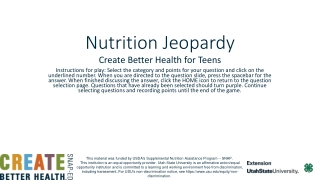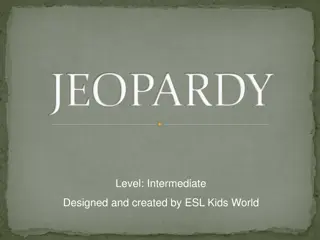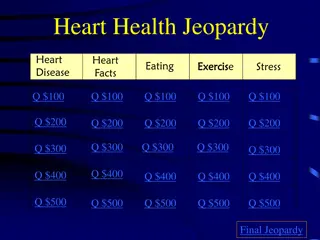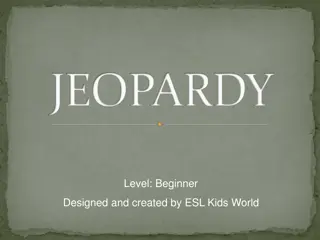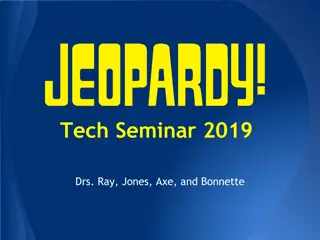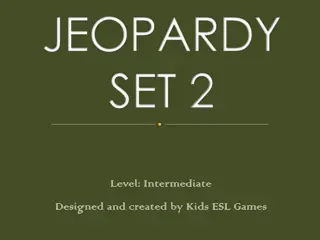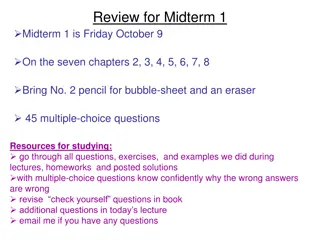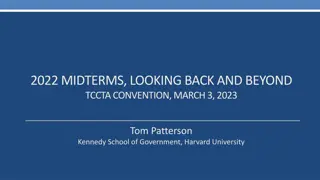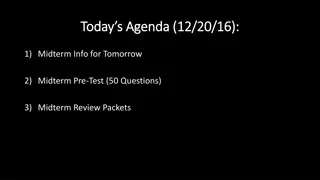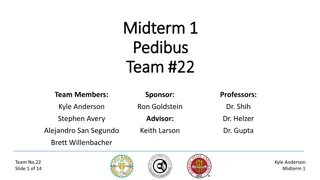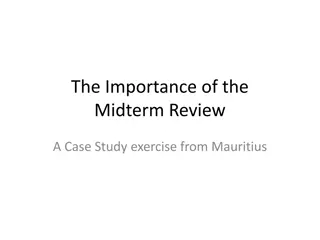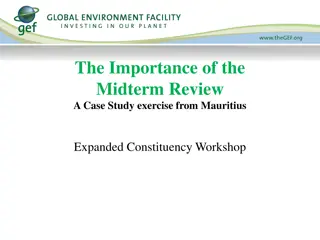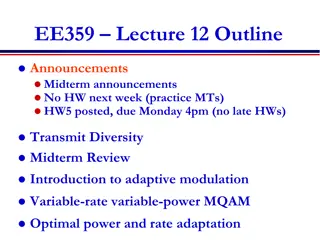
Exploring Cell Theory and Organism Classification
This content delves into the fundamental concepts of cell theory, distinguishing between prokaryotic and eukaryotic cells, and understanding the functions of different cell organelles. It also covers the characteristics of organisms, including their classification based on factors like cell structure, mode of reproduction, and nutrition. Students can enhance their knowledge of plant and animal cells, cellular functions, and levels of biological organization through engaging activities like Science Jeopardy.
Download Presentation

Please find below an Image/Link to download the presentation.
The content on the website is provided AS IS for your information and personal use only. It may not be sold, licensed, or shared on other websites without obtaining consent from the author. If you encounter any issues during the download, it is possible that the publisher has removed the file from their server.
You are allowed to download the files provided on this website for personal or commercial use, subject to the condition that they are used lawfully. All files are the property of their respective owners.
The content on the website is provided AS IS for your information and personal use only. It may not be sold, licensed, or shared on other websites without obtaining consent from the author.
E N D
Presentation Transcript
Science Jeopardy Hosted by the HMS 7th Grade Science Teachers Reproduction, Natural Selection/Selective Breeding 2nd six weeks info Eu , pro cells cell theory Classifying & I m Not Organized Cells and stuff 100 200 100 200 100 200 100 200 100 200 300 300 300 300 300 400 400 400 400 400 500 500 500 500 500 Final Jeopardy
Student Expectations Recognize that according to cell theory all organisms are composed of cells and cells carry on similar functions such as extracting energy from food to sustain life. (Supporting Standard) 7.12 F Differentiate between structure and function in plant and animal cell organelles, including cell membrane, cell wall, nucleus, cytoplasm, mitochondrion, chloroplast and vacuole. (Supporting Standard) 7.12 D Compare the functions of a cell to the functions of organisms such as waste removal. 7.12 E Recognize levels of organization in plants and animals, including cells, tissues, organs, organ systems, and organisms. 7.12 C Identify the basic characteristics of organisms, including prokaryotic or eukaryotic, unicellular or multicellular, autotrophic or heterotrophic, and mode of reproduction, that further classify them in the currently recognized Kingdoms. (Supporting Standard) 6.12 D
Answer Question
PROKARYOTIC No nucleus, nuclear membrane or membrane covered organelles Only found in one-celled organisms like bacteria Smallest cells bacteria EUKARYOTIC Has a nucleus, nuclear membrane, & membrane covered organelles (plants & animals, fungi (plants & animals, fungi, , protist protist) ) Answer Question
A-100 ANSWER: 1. Cells are the basic unit of structure and function of living things (FFF-form fits function, ex. blood cells are round, muscles cells are elongated ) 2. All living things are made up of one or more cells 3. All cells come from preexisting cells. (all cells are able to produce new cells) QUESTION: What are the three parts of cell theory? Answer Question
A-200 ANSWER: Name for a simple cell that has no nucleus, no nuclear membrane, and no membrane bound organelles. QUESTION What is a prokaryote or prokaryotic cell? *(Eucaryotes have all of these.) Answer Question
A-300 ANSWER: Plants make there own food. They do not have to rely on others for their food. QUESTION: Plants are autotrophic. What is autotrophic ? Answer Question
A-400 Mold *(A type of fungus) bacteria fern butterfly QUESTION: What do these 4 have in common or what are all of these made of? ANSWER: They are all made of cells Answer Question
A-500 ANSWER: Prokaryotic or eukaryotic, unicellular or multicellular, autotrophic or heterotrophic, and mode of reproduction are all basic characteristics of organisms used to do this. QUESTION: What is classify organisms into kingdoms Answer Question
B-100 ANSWER: One moves oxygen into the body and the other moves oxygen and nutrients through the body to every cell. QUESTION: What is the function of the cardiovascular/circulatory system and respiratory system? or What is the difference between the Answer Question
B-200 ANSWER: cells, tissues, organs, organ systems, and organisms. QUESTION: What is the levels of organization in plants and animals? Answer Question
B-300 ANSWER: A collection of cells with a specific role is a tissue. A group of tissues with a specific role forms an (the liver, heart, kidneys, brain and stomach are each examples) QUESTION: What is an organ ? Answer Question
B-400 ANSWER: Water is absorbed here which is a physical change. (see hint below) Order of digestion, I m a MESS at Lunch QUESTION: What is the large intestine? Answer Question
B-500 ANSWER: Identify the 2 organelles you would find in a plant cell but not in an animal cell. QUESTION: What is the cell wall and chloroplasts? Answer Question
C-100 ANSWER: This is the control center of the cell and where DNA (genetic material) is stored that determine an organism s inherited traits. QUESTION: What is the nucleus? Plural form: nuclei Answer Question
C-200 ANSWER: In the genes within chromosomes in the nucleus. QUESTION: What is where is DNA (or genetic material) found in the cell. Answer Question
C-300 ANSWER: This is a word for all the small bodies (Parts) in the cell that each have a specific function or job to do. QUESTION: What are organelles? Answer Question
C-400 ANSWER: Organelle used for storage of water in plant cells and storage of food in animal cells. QUESTION: What is a vacuole? Answer Question
C-500 QUESTION: All of these are inherited traits EXCEPT: Blue Eyes, Blond Hair, Widows Peak, and Throwing a ball ANSWER: throwing a ball Answer Question
D-100 The _________ system brings oxygen into the body and the __________ system carries it to all parts of the body. Respiratory, circulatory Answer Question
D-200 As carbohydrates are digested a broken down by the body they are converted into _________. sugars Answer Question
D-300 (a bird eating a worm) Energy Transformations ___________ energy of the worm is transformed into ______ energy (to keep the bird warm), and __________ energy (movement). chemical, heat or thermal, mechanical Answer Question
D-400 ANSWER: The major difference between an organic and inorganic compound QUESTION: Organic compounds contain the element carbon (C). Inorganic compounds usually do not contain carbon (exception example: carbon dioxide or monoxide CO2 or CO) Answer Question
D-500 Which of these is an organic compound NaCl C6H12O6 CO2 H20 C6H12O6 Answer Question
E-100 ANSWER: A reproductive process that involves only one parent and the offspring is/are genetically identical to the parent. QUESTION: What is Asexual reproduction Answer Question
E-200 ANSWER: A type of asexual reproduction in which one cell divides into 2 identical daughter cells. Occurs in prokaryotic cells. Example: amoeba QUESTION: What is Binary Fission Answer Question
E-300 ANSWER: A type of asexual reproduction in which one cell divides into 2 genetically identical daughter cells. Occurs in prokaryotic cells. (example: amoeba) QUESTION: What is Binary Fission Answer Question
E-400 ANSWER: Process by which Usable or Favorable traits are passed down and less favorable traits become less common or nonexistent. (ex. Peppered moths (camouflage activity) and Galapagos Island Finches (Battle of the Beaks activity) QUESTION: Natural Selection Answer Question
E-500 ANSWER: Crickets communicate with other crickets by chirping. Crickets who cannot make a sound are less likely to find a mate and reproduce. For this reason, there are few crickets that cannot make sound. This is an example of QUESTION: What is Natural Selection? Answer Question
FINAL JEOPARDY ANSWER: Which of the following is NOT a part of cell theory? All organisms are composed of cells Cells are the basic unit of structure and function in living things. All organisms are composed of many cells New cells are produced from existing cells QUESTION: What is all organisms are composed of many cells? Answer Question

